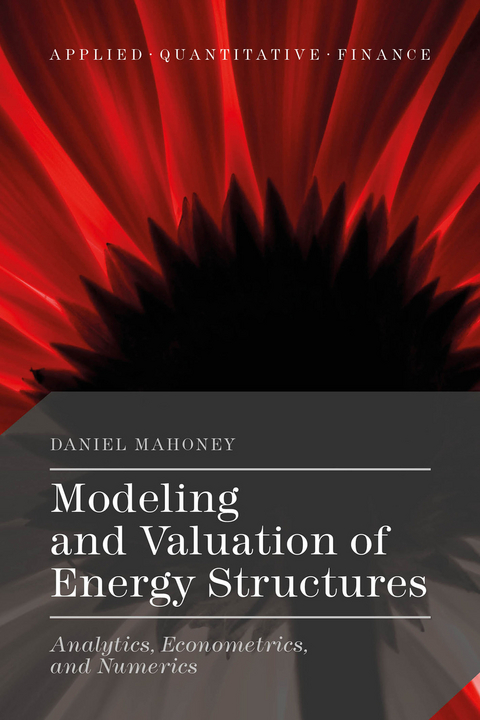
Modeling and Valuation of Energy Structures
Palgrave Macmillan (Verlag)
9781137560148 (ISBN)
Commodity markets present several challenges for quantitative modeling. These include high volatilities, small sample data sets, and physical, operational complexity. In addition, the set of traded products in commodity markets is more limited than in financial or equity markets, making value extraction through trading more difficult. These facts make it very easy for modeling efforts to run into serious problems, as many models are very sensitive to noise and hence can easily fail in practice.
Modeling and Valuation of Energy Structures is a comprehensive guide to quantitative and statistical approaches that have been successfully employed in support of trading operations, reflecting the author's 17 years of experience as a front-office 'quant'. The major theme of the book is that simpler is usually better, a message that is drawn out through the reality of incomplete markets, small samples, and informational constraints. The necessary mathematical tools for understanding these issues are thoroughly developed, with many techniques (analytical, econometric, and numerical) collected in a single volume for the first time. A particular emphasis is placed on the central role that the underlying market resolution plays in valuation. Examples are provided to illustrate that robust, approximate valuations are to be preferred to overly ambitious attempts at detailed qualitative modeling.
Dan Mahoney has over 17 years of experience as an energy quant in support of trading, structuring, and origination. He has extensive experience in mathematical and financial modeling with an emphasis on the valuation of volatility-related structures. He has held positions at Mirant, FPL, Sempra, Societe Generale, Trafigura, Swiss Re, and Citigroup, where he has been responsible for model development and infrastructure. His background covers a wide range of deals, both physical and financial, including tolling, full requirements, gas storage, and transport. He holds degrees from Caltech and MIT, US.
Dedication Acknowledgments Introduction PART I: APPLICATIONS 1. Synopsis of Energy Markets and Structures 1.1. Challenges of Modeling in Energy Markets 1.2. High Volatilities/Jumps 1.3. Small Samples 1.4. Structural Change 1.5. Physical/Operational Constraints 1.6. Characteristic Structures 1.7. Tolling Arrangements 1.8. Gas Transport 1.9. Gas Storage 1.10. Load Serving 1.11. Prelude to Robust Valuation 2. Data Analysis and Statistical Issues 2.1. Stationary vs. Non-Stationary Processes 2.2. Concepts 2.3. Basic Discrete Time Models: AR and VAR 2.4. Variance Scaling Laws and Volatility Accumulation 2.5. The Role of Fundamentals and Exogenous Drivers 2.6. Time Scales and Robust Estimation 2.7. Jumps and Estimation Issues 2.8. Spot Prices 2.9. Forward Prices 2.10. Demand Side: Temperature 2.11. Supply Side: Heat Rates, Spreads, and Production Structure 2.12. A Recap 3. Valuation, Portfolios, and Optimization 3.1. Optionality, Hedging, and Valuation 3.2. Valuation as a Portfolio Construction Problem 3.3. Black Scholes as a Paradigm 3.4. Static vs. Dynamic Strategies 3.5. More on Dynamic Hedging: Rolling Intrinsic 3.6. Market Resolution and Liquidity 3.7. Hedging Miscellany: Greeks, Hedge Costs and Discounting 3.8. Incomplete Markets and The Minimal Martingale Measure 3.9. Valuation and Dynamic Strategies 3.10. Residual Risk and Portfolio Analysis 3.11. Stochastic Optimization 3.12. Stochastic Dynamic Programming and HJB 3.13. Martingale Duality 3.14. Appendix 3.15. Vega Hedging and Value Drivers 3.16. Value Drivers and Information Conditioning 4. Selected Case Studies 4.1. Storage 4.2. Tolling 4.3. Appendix 4.4. (Monthly) Spread Option Representation of Storage 4.5. Lower Bound Tolling Payoff PART II: TOOLS 5. Analytical Techniques 5.1. Change of Measure Techniques 5.2. Review/Main Ideas 5.3. Dimension Reduction/Computation Facilitation/Estimation Robustness 5.4. Max/Min Options 5.5. Quintessential Option Pricing Formula 5.6. Symmetry Results: Asian Options 5.7. Affine Jump Diffusions/Characteristic Function Methods 5.8. Lévy Processes 5.9. Stochastic Volatility 5.10. Pseudo-Unification: Affine Jump Diffusions 5.11. General Results/Contour Integration 5.12. Specific Examples 5.13. Application to Change of Measure 5.14. Spot and Implied Forward Models 5.15. Fundamental Drivers and Exogeneity 5.16. Minimal Martingale Examples 5.17. Appendix 5.18. More Asian Option Results 5.19. Further Change of Measure Applications 6. Econometric Concepts 6.1. Cointegration and Mean Reversion 6.2. Basic Ideas 6.3. Granger Causality 6.4. VECM 6.5. Connection to Scaling Laws 6.6. Stochastic Filtering 6.7. Basic Concepts 6.8. The Kalman Filter and Its Extensions 6.9. Heston vs. GARCH 6.10. Sampling Distributions 6.11. The Reality of Small Samples 6.12. Wishart Distribution and More General Sampling Distributions 6.13. Resampling and Robustness 6.14. Basic Concepts 6.15. Information Conditioning 6.16. Bootstrapping 6.17. Estimation in Finite Samples 6.18. Basic Concepts 6.19. MLE and QMLE 6.20. GMM, EMM, and Their Offshoots 6.21. A Study of Estimators in Small Samples 6.22. Spectral Methods 6.23. Appendix 6.24. Continuous vs. Discrete Time 6.25. Estimation Issues for Variance Scaling Laws 6.26. High Frequency Scaling 7. Numerical Methods 7.1. Basics of Spread Option Pricing 7.2. Measure Changes 7.3. Approximations 7.4. Conditional Expectation as a Representation of Value 7.5. Interpolation and Basis Function Expansions 7.6. Pearson and Related Approaches 7.7. The Grid Model 7.8. Further Applications of Characteristic Functions 7.9. Quadrature 7.10. Gaussian 7.11. High Dimensions 7.12. Simulation 7.13. Monte Carlo 7.14. Variance Reduction 7.15. Quasi-Monte Carlo 7.16. Stochastic Control and Dynamic Programming 7.17.Hamilton-Bellman-Jacobi Equation 7.18. Dual Approaches 7.19. LSQ 7.20. Duality (Again) 7.21. Complex Variable Techniques for Characteristic Function Applications 7.22. Change of Contour/Change of Measure 7.23. FFT and Other Transform Methods 8. Dependency Modeling 8.1. Dependence and Copulas 8.2. Concepts of Dependence 8.3. Classification 8.4. Dependency: Continuous vs. Discontinuous Processes 8.5. Consistency: Static vs. Dynamic 8.6. Wishart Processes 8.7. Signal and Noise in Portfolio Construction 8.8. Random Matrices 8.9. Principal Components and Related Concepts References
| Erscheint lt. Verlag | 17.11.2015 |
|---|---|
| Reihe/Serie | Applied Quantitative Finance |
| Zusatzinfo | XVIII, 455 p. |
| Verlagsort | Basingstoke |
| Sprache | englisch |
| Maße | 155 x 235 mm |
| Themenwelt | Mathematik / Informatik ► Mathematik ► Angewandte Mathematik |
| Naturwissenschaften | |
| Wirtschaft ► Allgemeines / Lexika | |
| Wirtschaft ► Betriebswirtschaft / Management ► Finanzierung | |
| Wirtschaft ► Volkswirtschaftslehre ► Ökonometrie | |
| ISBN-13 | 9781137560148 / 9781137560148 |
| Zustand | Neuware |
| Informationen gemäß Produktsicherheitsverordnung (GPSR) | |
| Haben Sie eine Frage zum Produkt? |
aus dem Bereich


